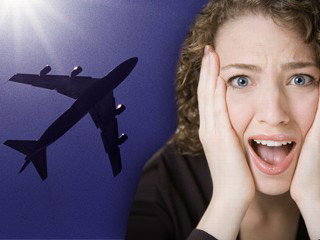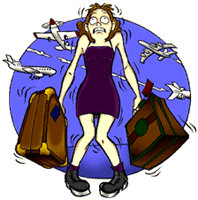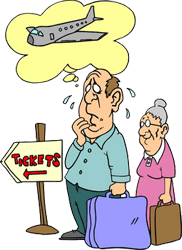|
Do you suffer from fear of
flying? If you do you are alone. Aerophobia is widespread, affecting a
significant minority of the population.
 It
may prevent a person from going on vacations or visiting family and
friends, and it can severely damage the career of a businessperson by
preventing him or her from travelling on work-related business. It
may prevent a person from going on vacations or visiting family and
friends, and it can severely damage the career of a businessperson by
preventing him or her from travelling on work-related business.
Millions of people around the world think of flying as an anxiety-filled
nightmare. Fear of flying may be a distinct phobia in itself, or it may
be an indirect combination of one or more other phobias, such as
claustrophobia (a fear of enclosed spaces) or acrophobia (a fear of
heights). Sufferers cope in a variety of ways: taking tranquilizers,
taking large quantities of alcohol before a flight or by simply not
getting into a plane. This final option is one which is becoming
increasingly impractical. Whether for business or pleasure, travel has
become an everyday necessity, and in many instances the only realistic
choice is to grit your teeth, take a deep breath, fasten your seatbelt
and take off.
Whether we like flying or not, sooner or later most of us will have to
fly, and possibly one of the best ways to deal with it is to take a long
hard look at the facts and the scientific evidence before us.
 In
recent years, a number of statistics have been published which put the
danger of flying into a more realistic perspective. Although plane
crashes seem to appear on the news with alarming frequency, we should
also take into account that this is balanced by the fact that the number
of flights has also increased. In the early 1950’s, the chance of a
fatal accident in a plane was around 18 in a million; that figure is now
less than one in 12 million (including smaller aircraft). In the 2009,
there were 120 fatal plane crashes worldwide, and 1,103 deaths. The
worst year for crashes was 1972 with 3,214 fatalities. According to the
statistics published by ACRO in Geneva, the three safest airlines are
British Airways, Singapore Airlines and Dutch airline KLM, with the
Australian carrier Qantas coming in fourth. The worst accident record is
held by the Russian airline Aeroflot. In
recent years, a number of statistics have been published which put the
danger of flying into a more realistic perspective. Although plane
crashes seem to appear on the news with alarming frequency, we should
also take into account that this is balanced by the fact that the number
of flights has also increased. In the early 1950’s, the chance of a
fatal accident in a plane was around 18 in a million; that figure is now
less than one in 12 million (including smaller aircraft). In the 2009,
there were 120 fatal plane crashes worldwide, and 1,103 deaths. The
worst year for crashes was 1972 with 3,214 fatalities. According to the
statistics published by ACRO in Geneva, the three safest airlines are
British Airways, Singapore Airlines and Dutch airline KLM, with the
Australian carrier Qantas coming in fourth. The worst accident record is
held by the Russian airline Aeroflot.
The increase in the safety of flight is largely due to technical
improvements and stricter regulations. Huge advances were made in the
1970’s with the introduction of turbofan jet engines, more powerful,
quieter and easier to maintain than the turbojet engines they replaced.
Computer technology made it possible to develop autopilot systems, and
in the 1980’s these reached the stage where an entire flight, including
landing, could be controlled automatically. Ground Proximity Warning
Systems and Wind Shear Alert Systems were introduced on the ground and
the Federal Aviation Authority established Terminal Control Areas to
prevent collisions around busy airports with high traffic density.
Unfortunately, improvements in technology cannot be relied upon to
prevent accidents. At an average of 54% during the last decade, human
error is by far the largest factor in aircraft disasters (pilot error
alone accounted for 45%). Mechanical failure accounted for 28% of
accidents during the last ten years, and the weather was blamed for 8%
of all accidents. Only 9% was due to terrorist attack or sabotage.
At a time when delays are commonplace, pilots frequently have to work
for longer than the recommended shift. According to the Federal Aviation
Administration, pilots can work up to a 16 hours a day. Combine this
with virtually automatic control systems and you have a situation in
which tired pilots, with little to do, find it difficult to stay awake.
On some airlines, the cabin crew is advised to visit the cockpit every
15 minutes, just to check that the flight crew are awake!
Aircraft maintenance is another major cause for concern. Sceptics fear
that cheap, cost-cutting airlines may cut corners in this crucial area.
Add this to the continuing threat from terrorist attacks and you would
be forgiven for sympathising with those who refuse to fly.
However, in the final analysis, it’s important to see the situation in a
statistical perspective. As the numbers show, if you only fly with the
top 25 safest airlines in the world, you have a one in 13.57 million
chance of meeting with a fatal accident. That’s about as likely as being
struck by lightening.
* Statistics sources:
- The Aircraft Crashes Record Office (ACRO) – Geneva.
- faqs.org
- airsafe.com
- planecrashinfo.com |


![]() Before you read an article on Aerophobia (fear of flying), read the following
questions.
Before you read an article on Aerophobia (fear of flying), read the following
questions.
![]() Now answer the questions.
Now answer the questions.
![]() Now read the article again and complete the following notes.
Now read the article again and complete the following notes.


 It
may prevent a person from going on vacations or visiting family and
friends, and it can severely damage the career of a businessperson by
preventing him or her from travelling on work-related business.
It
may prevent a person from going on vacations or visiting family and
friends, and it can severely damage the career of a businessperson by
preventing him or her from travelling on work-related business. In
recent years, a number of statistics have been published which put the
danger of flying into a more realistic perspective. Although plane
crashes seem to appear on the news with alarming frequency, we should
also take into account that this is balanced by the fact that the number
of flights has also increased. In the early 1950’s, the chance of a
fatal accident in a plane was around 18 in a million; that figure is now
less than one in 12 million (including smaller aircraft). In the 2009,
there were 120 fatal plane crashes worldwide, and 1,103 deaths. The
worst year for crashes was 1972 with 3,214 fatalities. According to the
statistics published by ACRO in Geneva, the three safest airlines are
British Airways, Singapore Airlines and Dutch airline KLM, with the
Australian carrier Qantas coming in fourth. The worst accident record is
held by the Russian airline Aeroflot.
In
recent years, a number of statistics have been published which put the
danger of flying into a more realistic perspective. Although plane
crashes seem to appear on the news with alarming frequency, we should
also take into account that this is balanced by the fact that the number
of flights has also increased. In the early 1950’s, the chance of a
fatal accident in a plane was around 18 in a million; that figure is now
less than one in 12 million (including smaller aircraft). In the 2009,
there were 120 fatal plane crashes worldwide, and 1,103 deaths. The
worst year for crashes was 1972 with 3,214 fatalities. According to the
statistics published by ACRO in Geneva, the three safest airlines are
British Airways, Singapore Airlines and Dutch airline KLM, with the
Australian carrier Qantas coming in fourth. The worst accident record is
held by the Russian airline Aeroflot. 

